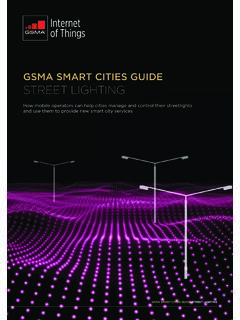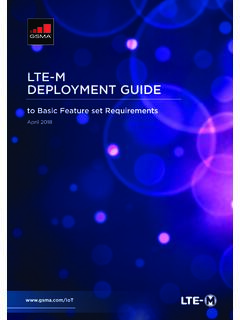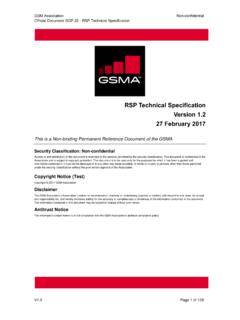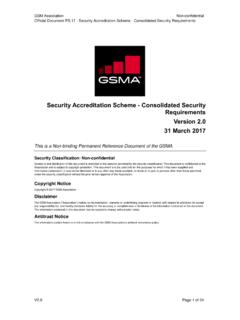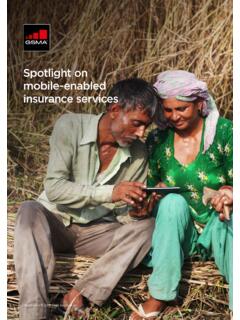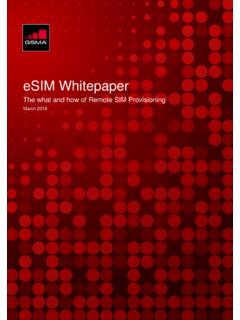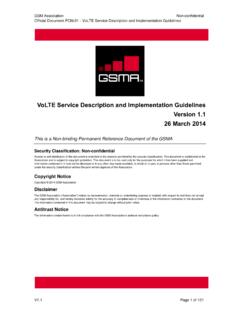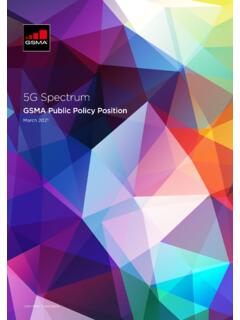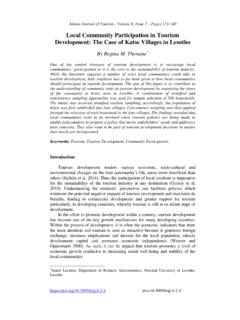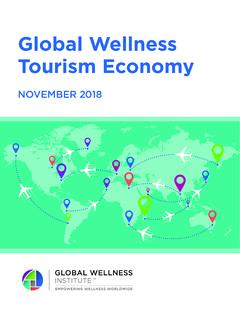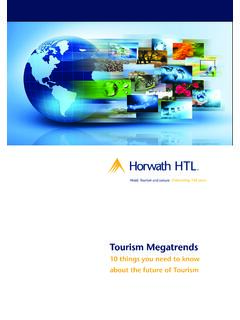Transcription of International roaming explained - GSMA
1 International roaming explainedLatin America3 Contents1. Mobile roaming 12. Mobile roaming in Latin 53. Price 114. Impact of 135. Best 151 International mobile roaming is a service that allows mobile users to continue to use their mobile phone or other mobile device to make and receive voice calls and text messages, browse the internet, and send and receive emails, while visiting another extends the coverage of the home operator s retail voice and SMS services, allowing the mobile user to continue using their home operator phone number and data services within another country. The seamless extension of coverage is enabled by a wholesale roaming agreement between a mobile user s home operator and the visited mobile operator network. The roaming agreement addresses the technical and commercial components required to enable the most common International roaming services are: Voice : Making and receiving calls to or from home country, visited country or a third country, while abroad SMS: Sending and receiving text messages to or from home country, visited country or a third country, while abroad Email: Reading and replying to emails while abroad Mobile broadband: Using mobile devices or dongles to access the internet, including downloading images, MP3s, films and software, while abroad Applications.
2 Using mobile applications while abroad that require mobile data, such as location-based services and language mobile roaming is one of a wider range of communications services offered to mobile users while travelling abroad, which also include hotel services, Wi-Fi, national travel SIMs, and visited operator Mobile roaming explainedFigure Overview of International roaming technology and operationsInitiated callReceived callVisited operatorHomeoperatorReceiver s homeoperatorInternationaltransitservices 2To explain roaming in more detail, Figure the shows commercial and technical details for International mobile roaming . The diagram focuses on the International roaming wholesale and retail arrangements, for mobile user (Mobile User A) has an International roaming service with their home operator (Home Operator) and is automatically connected to a visited network (Visited Operator A) while roaming . Mobile User A is automatically granted access to Visited Operator A s network when arriving in the visited country by an exchange of a data between Home Operator and Visited Operator A, where Visited Operator A confirms Mobile User A is a roaming customer with Home Operator.
3 As such, the wholesale roaming agreement between Visited Operator A and Home Operator specifies how this data is to be provided to the visited operator. Home Operator usually has wholesale roaming agreements with more than one operator in the same visited country, which in this case is Visited Operator A and a second network, Visited Operator B. As a result, Mobile User A can call home using either visited operator networks, both of which use International transit services to carry the call back to Mobile User A s home User A pays a retail price to Home Operator for the roaming service and does not pay Visited Operator A. Provided Mobile User B is not also roaming , they will not incur any extra charges to receive a call from, or to make calls to Mobile User Operator A sends transferred account procedure (TAP) files to a clearing house which forwards them to the Home Operator. TAP files are used for billing of calls while Operator can then pay Visited Operator A the wholesale charges as per call volumes in the TAP file and rates in the wholesale roaming mobile roaming worksWhen a mobile user is abroad and turns their mobile device on, the mobile device attempts to communicate with a visited mobile network.
4 The visited network picks up the connection from the user s mobile, recognises whether 3 Visited Operator A pays an International carrier ( International Carrier) for carrying the call and handing over the call to Home Operator. International Carrier pays Home Operator a termination rate for terminating the call in the home cou nt r Commercial links required for International mobile roamingit is registered with its system, and attempts to identify the user s home network. If there is a roaming agreement between the home network and one of the mobile networks in the visited country, the call is routed by the visited network towards an International transit network (Figure ). The International transit network carrier is responsible for the call delivery to the destination network. Once this is done, the destination network will connect the visited network also requests service information from the home network about the user, such as whether the phone being used is lost or stolen, and whether the mobile device is authorised for International use.
5 If the phone is authorised for use, the visited network creates a temporary subscriber record for the device and the home network updates its subscriber record on where the device is located so if a call is made to the phone it can be appropriately servicesTraffic flowRevenue flowData exchangeRoaming servicesTraffic flowRevenue flowData exchangeMobileUser BMobileUser ARETAILWHOLESALEH omeoperatorClearing houseRoaming agreementInternationalcarrierVisitedoper ator BVisitedoperator AMobileUser BMobileUser ARETAILWHOLESALEH omeoperatorClearing houseRoaming agreementInternationalcarrierVisitedoper ator BVisitedoperator A4 Data roamingWith the increasing popularity of feature phones and smartphones, the use of mobile data services while roaming is set to continue to grow exponentially. Mobile data services are typically measured in kilobytes (KB) or megabytes (MB), which refers to the volume of data transmitted for the service used.
6 Data traffic volumes can vary significantly depending on the type and use of different data traffic useOne hour of instant messaging 1 MBOne hour of web browsing 25 MBDownload 100 emails 1 10 MB100 minutes talk on VoIP video callingAround 50 MBDownload one photo 2 MBDownload one MP3 3 8 MBOne software download 70 800 MBDownload one film 700 1500 MBStreaming one hour of video 250 500 MBStreaming one hour of audio50 150 MBFigure : Mobile data traffic volumes1 There are significant differences in the size estimates, as file size depends on the type of data, quality, and file length. For example, high definition and DVD quality streaming consumes greater amounts of mobile data than standard video or audio , the mobile environment is growing, both in subscribers and data traffic; however, roaming services are still emerging. Latin American countries are in different stages of economic development, with significant differences in inflation rates, currency exchanges, labor costs and GDP per capita.
7 GDP per capita in some countries is up to 12 times higher than in Additionally, compared with regions such as Europe, roaming penetration in Latin America is small. Just seven per cent of the region s population travelled abroad in 2011 (Figure ), with factors such as greater distances between countries and less affordable travel in the region contributing to this lower rate of travel. roaming use and its relevance as a service for mobile users varies significantly across the region. As a result, up to 90 per cent of roaming traffic from the region is Within Latin America, there are around 500 operator roaming agreements and this number is growing. As commerce and tourism develop, more roaming routes are becoming economically viable. roaming traffic flows are mainly across a number of key routes, although exact traffic patterns vary from operator to operator (Figure ).Both inter-regional and intra-regional roaming are major contributors to the Latin American roaming market.
8 The exact traffic pattern can vary significantly from operator to operator, depending on factors such as the country, consumer base and market Ratio of International trips to population %, 20113 Europe65%North America35%Asia Pacific10%Latin America7%2. Mobile roaming in Latin America6 Figure Main inter-regional and major intra-regional roaming routes for Latin America5 GuatemalaEl SalvadorNicaraguaHondurasLatin AmericaPortugal SpainNorth AmericaMexicoVenezuelaColombiaEcuadorBra zil PeruChileParaguayUruguayArgentinaMain inter-regional roaming routes Main intra-regional roaming routes: tourism Main intra-regional roaming routes: businessGuatemalaEl SalvadorNicaraguaHondurasLatin AmericaPortugal SpainNorth AmericaMexicoVenezuelaColumbiaEcuadorBra zil PeruChileParaguayUruguayArgentinaMain inter-regional roaming routes Main intra-regional roaming routes: tourism Main intra-regional roaming routes: business7 Regional challengesAs the Latin American market develops, structural and technical barriers must be addressed.
9 Introducing roaming regulation while these obstacles remain could result in unintended consequences that harm the industry, mobile users and government barriersLegal and technical developments are required to remove double taxation, combat fraud and liberalize International gateways. Combating these barriers is vital prior to any implementation of roaming regulation, as they artificially inflate roaming charges in individual countries. Double taxation inflates retail prices. This means retail prices can be inefficiently high, which affects the industry and mobile users, as well as government revenue. While initiatives by regulatory bodies such as the IIRSA (Initiative for the Integration of Regional Infrastructure in South America) exist to help remove double taxation, the problem continues and substantially increases roaming tariffs. In Latin America VAT rates range from seven to 27 per cent, complicating the task of roaming pricing for operators.
10 Few agreements have been reached to prevent double taxation in Latin America and some operators report that tax treaties in existence are operationally difficult to implement. In addition, many countries levy other local taxes, such as withholding taxes and local and state taxes, which further inflate prices. Double taxation remains on 72 per cent of roaming routes in South Fraud remains a major financial concern for operators despite increased eradication efforts, causing loses of up to five per cent of total mobile revenues in Latin America and up to 25 per cent can occur while users are The GSMA and regional bodies are leading initiatives to reduce fraud, and more than 80 per cent of Latin American operators have implemented Near Real Time Data roaming Exchange (NRTDRE). For fraud to be significantly reduced, NRTDRE must be enforced through roaming agreements, which requires further investment in technology and negotiation of roaming International gateways are the facilities through which International calls are sent and received.

